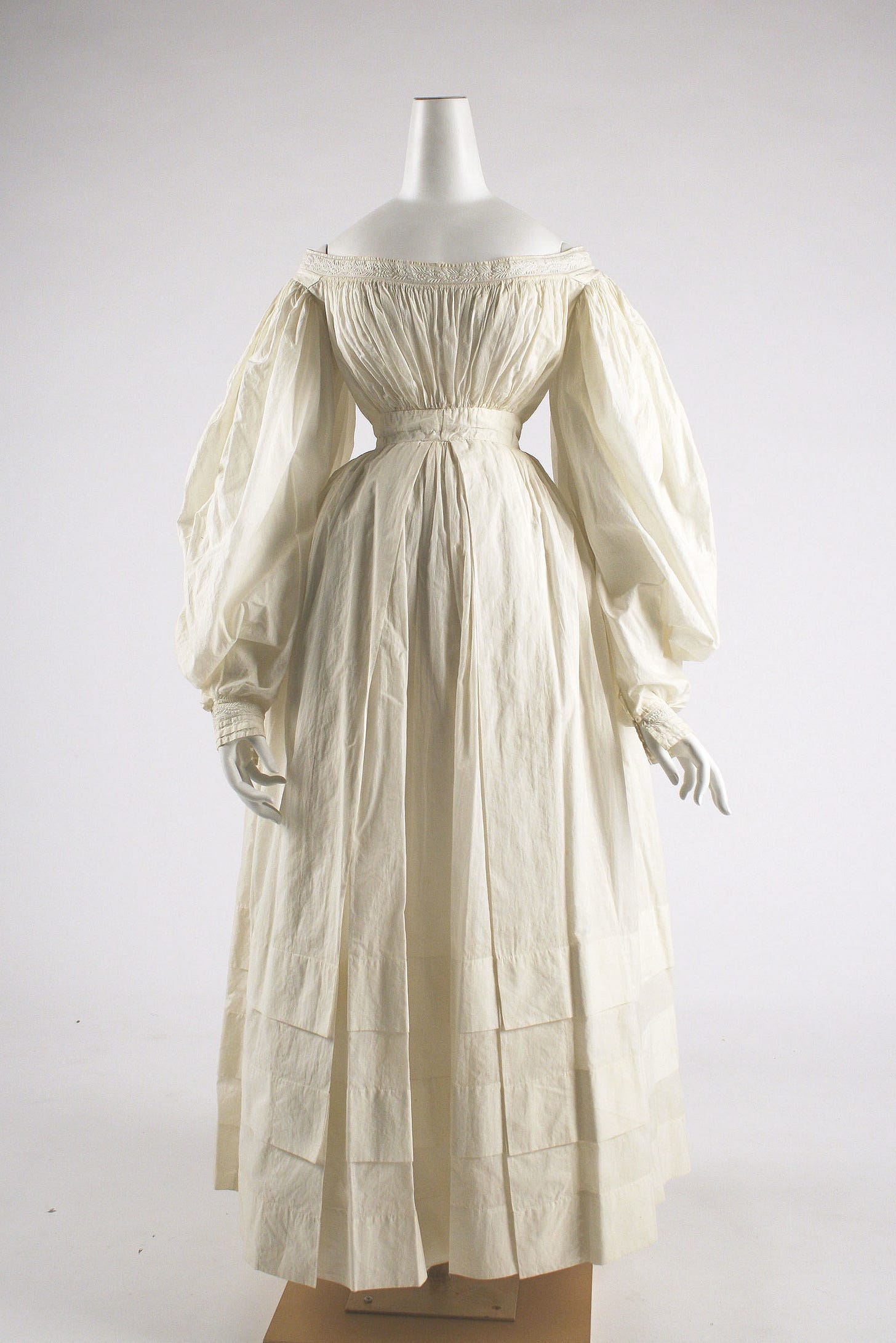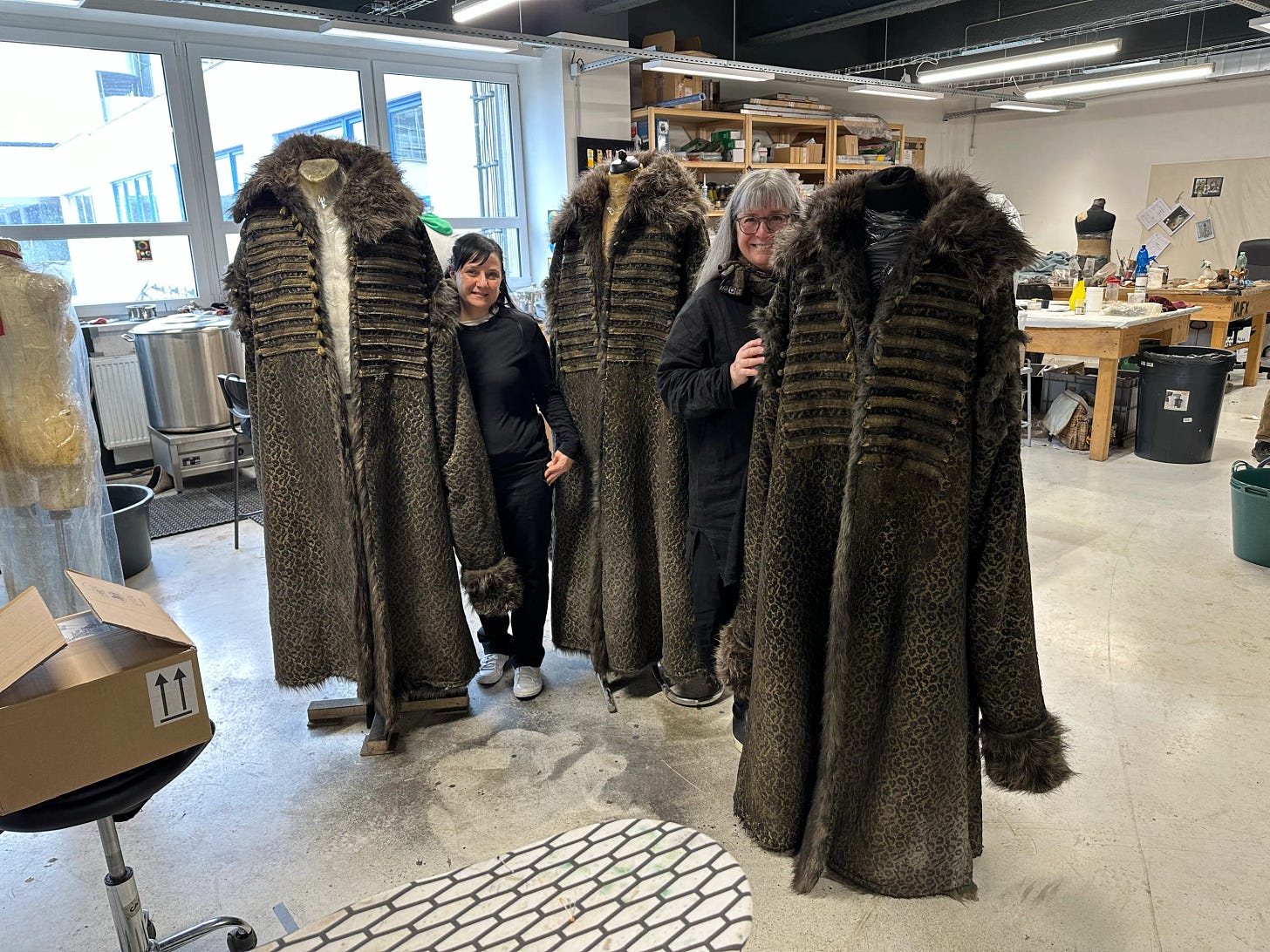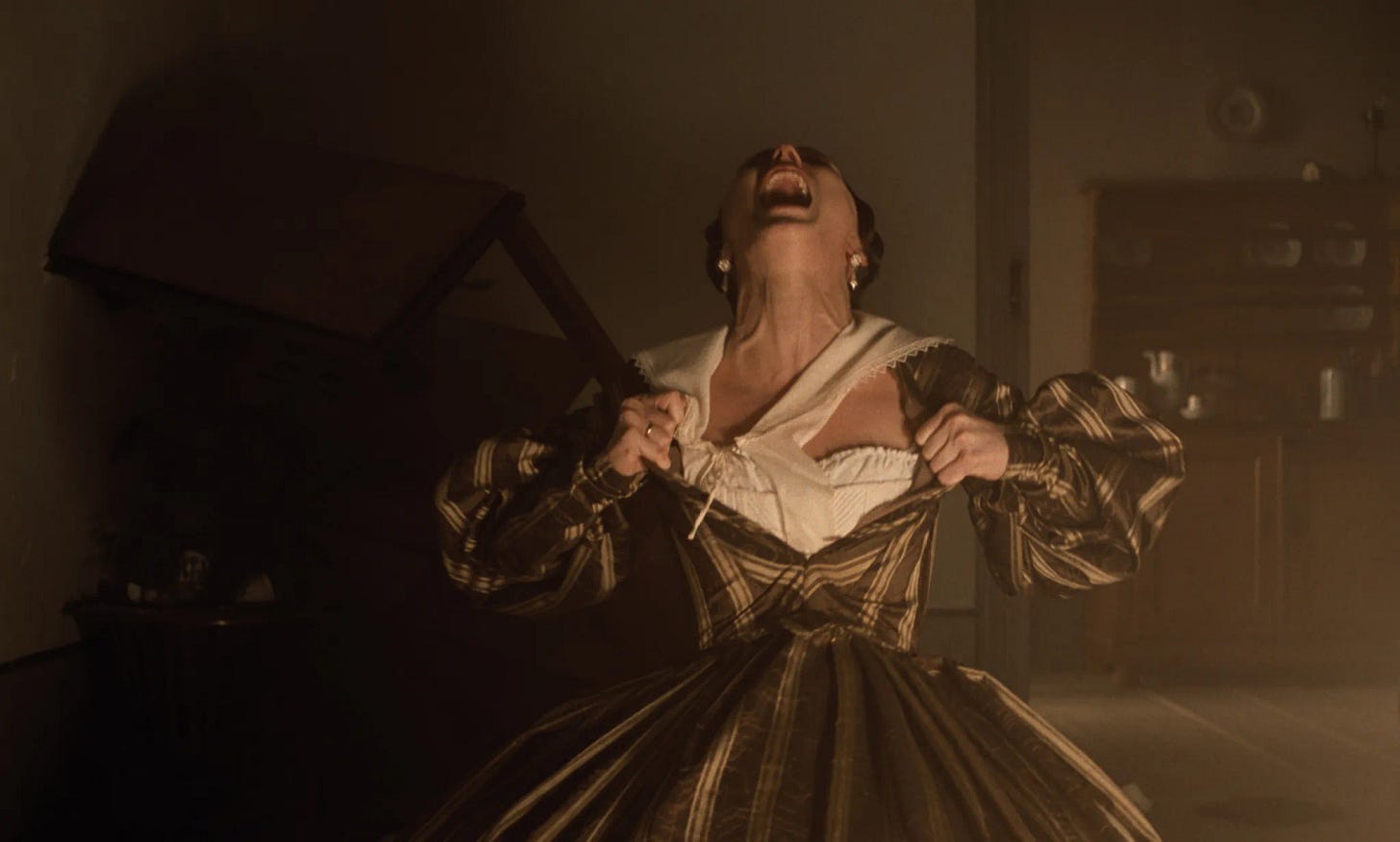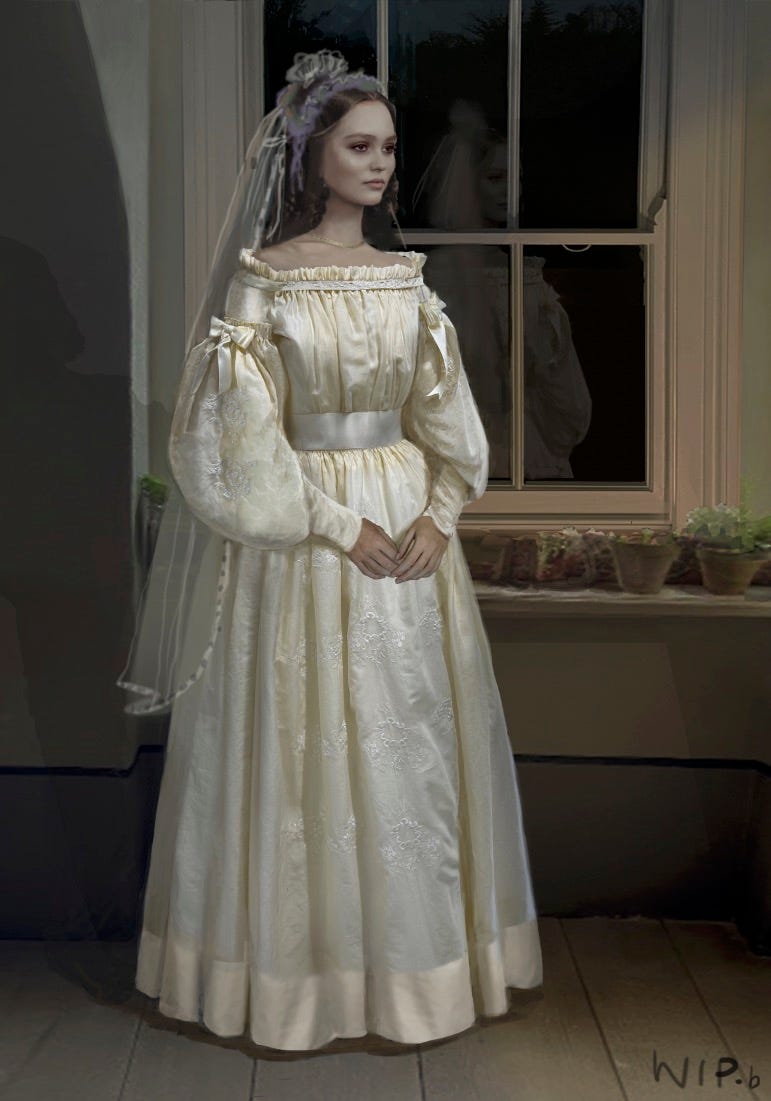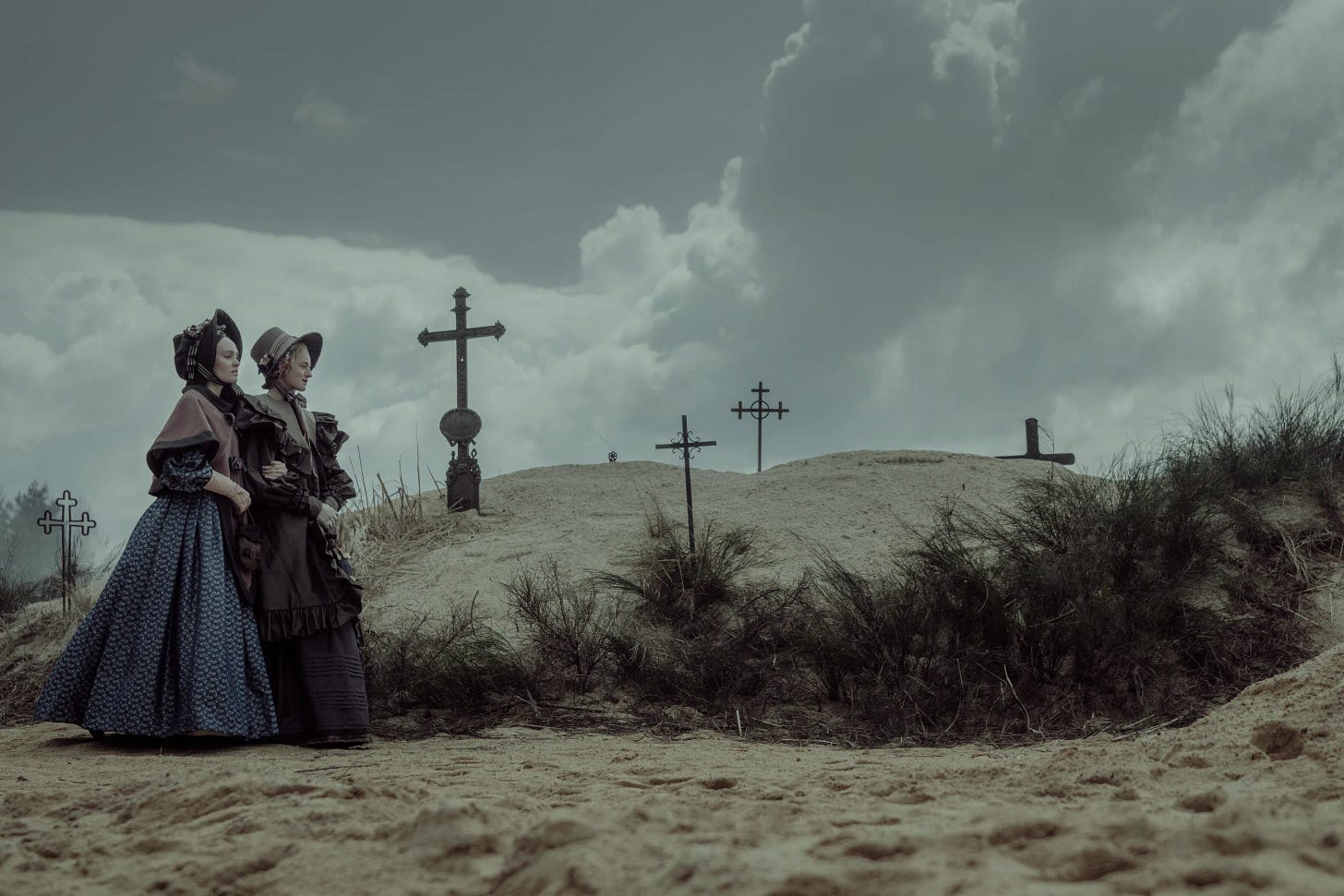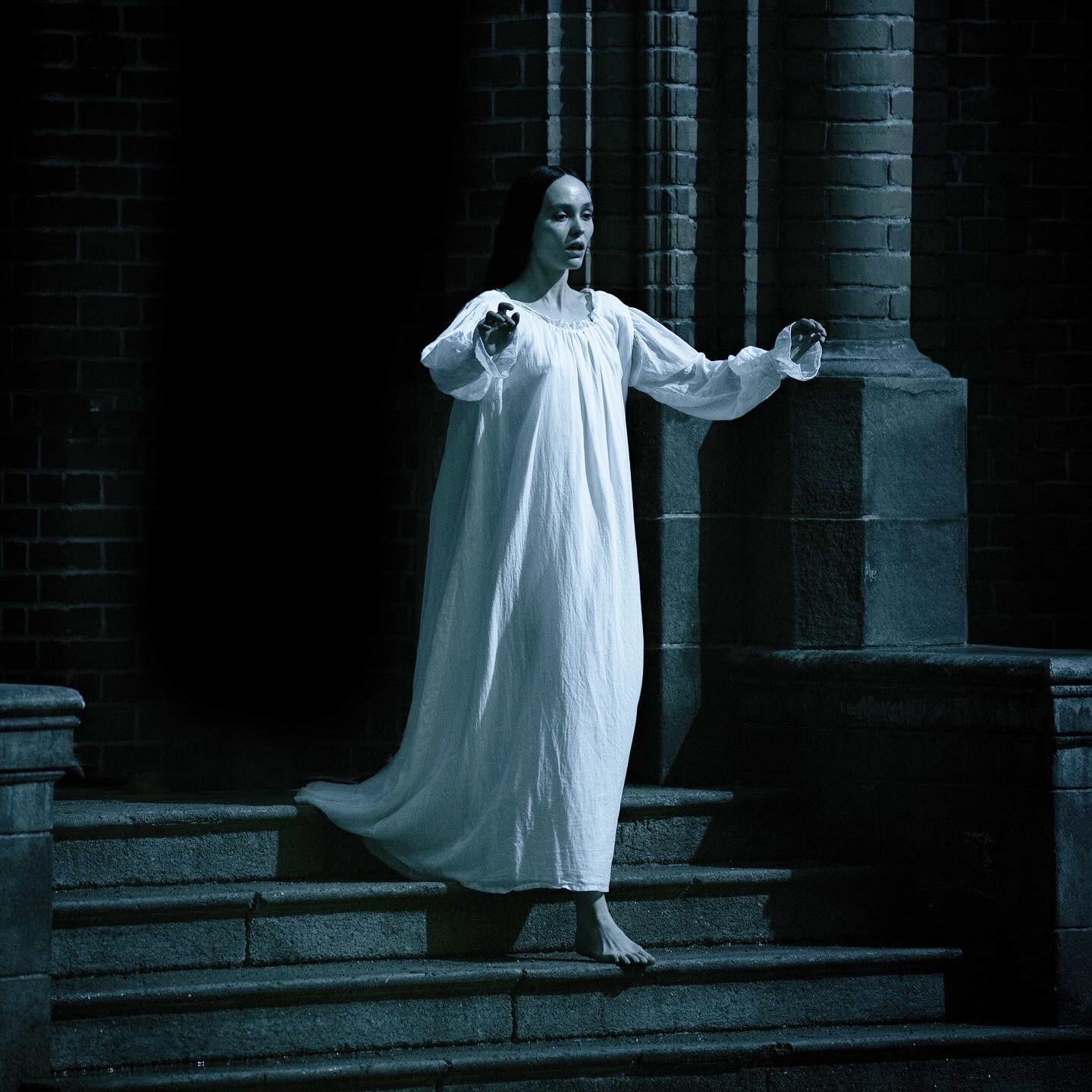I knew Robert Eggers matched my freak when I watched The Witch and saw the most period accurate Puritan dress I’ve ever seen in a movie/show in my entire life. It’s actually impossible for me not to bring it up when someone mentions that movie. Also, the original Nosferatu is a yearly, Halloween watch for me, so this remake was truly my Joker. I’m going to eat up every Dracula retelling that’s served to me, and a period accurate, Robert Eggers version?! I’d like seconds!!
This was definitely one of my favorite movies of the year, and the costumes were, of course, perfect. Unrelated to costumes, I think I could spend hours talking about Ellen alone, but for this analysis, I’ve decided to focus on Ellen and Count Orlock, but I’ll also be touching on Anna’s costumes as well.
I’m sure this is a story most people are familiar with, but Nosferatu follows Ellen, a woman who as a child prayed for any spirit to bring her love, and is presented with a vision of ghastly, shadow of a beast that causes her to have a seizure. Years later, in 1838 we see that Ellen lives in Germany with her husband, Thomas, who is a real estate agent. Thomas is tasked with selling a castle to Count Orlock, and must travel to Transylvania to get him to sign the paperwork. This is actually an occult pact between Orlock and Thomas’ employer— don’t you hate when that happens? Thomas realizes Orlok is a vampire and the beast from Ellen’s dreams, tries to escape, and eventually succeeds by jumping out of a window into the sea. He is rescued by Orthodox Romanian nuns, and leaves their care before he is well enough, because he knows Orlok is headed to London to claim his new home, but also to claim Ellen. Meanwhile, Ellen is sleepwalking and having seizures, and Dr. Sievers is like, this bitch has too much blood, but his mentor Albin Eberhart Von Franz is like, no dumbass, she’s under count Orlok’s spell!! Orlok eventually gets to London, bringing a plague of rats with him, and tells Ellen that if she doesn’t agree to divorce Thomas, he will kill everyone she loves, including him. He starts by killing her friend Anna and her two children, with Anna’s husband dying of the plague, but not without doing some freak shit with her dead body first— people grieve in different ways, I suppose. Ellen and Von Franz realize that the only way to kill Orlok is for Ellen to sacrifice herself to him, so Von Franz distracts Thomas and Sievers, while Ellen lets Orlok feed on her until sunrise, leading to his death, as he does not return to his coffin in time, but also to hers. Really great stuff.
Costumes were done by Linda Muir, who Robert Eggers has worked with in the past, and their collective slay continues to be unmatched when it comes to the delicious amount of research they do to be period accurate. Given that the movie takes place in Germany, Muir looked to German journals of the time, while also being mindful of the ways in which light worked against the garments throughout the movie.
When we look to fashion, specifically women’s dress, in 1838, we’re met with this in between time, where we’re looking back at 17th century fashion, while also having a changed world view after the French revolution. This time would also act as a prequel for early Victorian era fashion, but let’s not get carried away. In the earlier part of the decade, the waistline was still quite high, creating an hourglass silhouette, accompanied by large bonnets and extravagant hairstyles that drew even more attention to the middle of the body. As time went on, corsetry tightened and lengthened, and was stiffened with whalebone and additional steel busk support down the center. There were many layers of petticoats and the gigot sleeve starts to move lower down on the arm, almost as if slipping off the shoulder. Necklines were rounded and quite modest for daywear, but sat much lower, revealing a bit of shoulder, for evening ensembles— perfect for biting. Due to the low necklines, you can often see the chemise sticking out from beneath the layers on top. While white was a popular color for the time period, it was also a very fun time for patterns and colors.
The Romantic movement was flourishing, with its emphasis on the dreamy, the emotional, the natural, and the sublime. All that, with a rise in individualism, feels quite synergistic with the love and fantasy we have for vampires today. As Eggers has stated multiple times, the original stories of vampires were written by people who believed in and feared them. However, the allure of vampires has long been tied to a tension between danger and desire, which not only makes this vampire tale feel like it’s set in the perfect time period, but also parallels Ellen, a woman who has been made to feel endlessly guilty about her wants, desires, and darkness. While reflective of the time, first and foremost, the costumes also emphasize personal expression.
The use of rich, tactile fabrics in Nosferatu ties into the sensuality often associated with vampires. These materials evoke a tactile response, blurring the line between the real and the fantastical. Even making this shadow creature all the more terrifying, by bringing him beyond the dream. The vampiric narrative often involves themes of dominance and seduction, reflected in the interplay between Ellen’s vulnerability (enhanced by the soft, unstructured gowns she wears) and Orlok’s oppressive presence. As Elizabeth Wilson writes in Adorned in Dreams: Fashion and Modernity, fashion “carries both a symbolic and sensual message,” and, in the case of vampires, this message is often one of sensuality and death. Since the Victorian era, vampires have been seen as seductive figures, drawing in their victims with an otherworldly charm and an eroticized danger. The lavishness of their clothing embodies that sensuality. In Nosferatu, the costumes reflect this by juxtaposing elegance with a sinister edge. The fluidity of a vampire’s movements, often associated with their supernatural allure, is captured by long flowing capes, dark fabrics, and severe silhouettes that make Orlok almost one with the shadows. In The Empire of Fashion, Gilles Lipovetsky discusses how clothing can function as both a declaration of presence and an embodiment of absence. This duality is particularly relevant to Orlok. His garments simultaneously announce his arrival while allowing him to recede into obscurity, enhancing his otherworldly aura.
Speaking of Orlok, talking about menswear in Germany during 1838 would be null and void here since he is much older than everyone else. My guys been around since 1580 and is a Transylvanian nobleman. When talking about his garments in an interview, Muir said, “The more I researched, the more I uncovered this fascinating reality: the shepherds’ sheepskin cloaks evolved into sheepskin coats with impossibly long sleeves, which were never meant to have arms through them. Instead, they served as presentational garments—a way of showcasing wealth or status. For the nobility, like the counts, you’d see incredible layers beneath: dolmans, sashes, metallic lace, ornate buttons—it’s all very grand and presentational. Orlok, however, has reversed that entirely. He’s shrinking into his clothing, retreating into the layers as if to conceal his deteriorated state. Even his enormous kalpak hat—a piece that would have been worn differently by a younger man—is now part of his strategy to hide the grotesque reality of being 300 years old.”
The tailored, yet textured and lived in quality of Orlok’s garments speak to his unique and tragic experience. They were originally meant to be seen and admired, but have been inverted to mirror his own corruption, where the layers that once spoke of nobility now act as a barrier to hide his decay. It’s not just clothing— it’s an act of deception, a visual attempt to control the narrative of his identity by obscuring his physical appearance, with all the layers of fabric acting as a metaphor for the layers of history and the emotional weight of centuries of living in the shadows. His clothing becomes a mask, literally and figuratively hiding his age and rot, reflecting the “mask of morality” concept explored in the work of Thomas Laqueur, who examines how fashion can function as a metaphor for the human body’s life cycle.
Then there’s Ellen. A woman who’s deepest desires have been repressed all her life. Who feels that she is unclean and should not be touched, even by the man that she loves, and that fiercely loves her back. We often see Ellen wear darker, muted blues, purples, and prints. Muir did note that although prints were popular during this time, they would have been quite distracting in the film, but these subtle patterns and faded florals could also represent her complexity— she is torn between her natural wants and societal expectations. The muted tones prevent these prints from feeling ostentatious, reinforcing modesty. There is a lot of melancholy within her, and she has far too much too worry about to stress about her appearance. Ellen obviously comes from money, but as her outfit repeating and her only bringing necessities to stay with Anna and Friedrich imply, she doesn’t seem to be bothered by all of that as long as she has Thomas. She’s far more concerned with being right— her personal convictions represent her dress, which also aligns with the Romantic movement and individualism.
At night we see her in ethereal and diaphanous gowns that represent her fragility and emotionality. The fabrics flowing softly around her amplify her fragility, almost as if she is trapped in a dreamlike state, pulled between the expectations of the world and her own internal desires. When juxtaposed with Orlok’s vampiric predation, Ellen’s gowns take on a dual meaning. They are both a sign of her innocence, making her appear defenseless against his dark presence, and a symbol of her potential for liberation, suggesting a willingness to embrace her suppressed desires and instincts. Contrasting this is the fan laced corset she wears that the men tighten and loosen in relation to her fits. Perfectly chosen by Muir, to make us see the oppression clearly placed upon her.
Anna is very much the opposite of this. Everything she wears is very exact and on trend, as if pulled directly off of a fashion plate. This is very funny to no one except for fashion history nerds (me), because if you think people love a trend today, wait till you do just two seconds of research on 1830s fashion. Anyway, she also wears a lot of white, which is a color of the times, but is also associated with pureness and being untouched. Her luxuries are very much part of her character, and her garments are not just a reflection of who she is but an active projection of an image— one that is entirely detached from any deeper emotional narrative. She is the epitome of Romantic beauty, devoid of its complexities. Unlike Ellen, whose dress reflects emotional vulnerability, Anna’s ethereal clothing emphasizes beauty without sentimentality. She adopts these aesthetics purely for their visual appeal, and doesn’t really care to explore what is right and wrong. The contrast between the two women underscores the broader thematic tension between authenticity and artifice in the narrative. Anna represents a superficial ideal of femininity, while Ellen embodies the messy, complex reality of human emotion and morality.
Nosferatu and its costumes speak to the eternal dance between appearance and reality, light and shadow, humanity and monstrosity. Through its costumes, the film immerses us in a world where clothing is as much a marker of history as it is a reflection of the human (and inhuman) condition. Every layer of fabric tells a story; it’s a reflection of everything we hide, or everything we dare to reveal.
Alright, OMW to watch Babygirl.
TTYL!!!
xx





